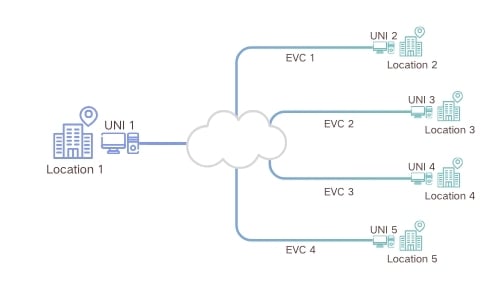Blog, Networking Device
EPL vs EVPL Network: What is the Difference
EPL (Ethernet Private Line) and EVPL (Ethernet Virtual Private Line) are two types of carrier Ethernet Layer 2 services defined by the Metro Ethernet Forum (MEF). They fit different application scenarios, and many people don’t know how to differentiate between EPL vs EVPL. This post will introduce their differences to help you choose the appropriate network service.
What is EPL
EPL is a point-to-point(P2P) dedicated service that links two locations. It bridges two User-to-Network Interfaces (UNI) with a sole-use Ethernet service. Such a connection is also called one Ethernet Virtual Circuit (EVC).

EPL doesn’t hit the external public Internet, although it uses the same cables as the Internet. You don’t need to compete with public Internet users for traffic. And traffic is delivered directly to the ISP’s site. EPL doesn’t offer Layer 3 and Internet services. It offers many benefits:
- Privately enjoyed bandwidth with low latency
- Scalability, 2Mbps – 10Gbps available
- QoS
- Secure, no external interference
- SLAs and Managed Services
- Redundancy
EPL is just like a VIP pathway that ensures your information reaches its destination directly and quickly.
What is EVPL?
EVPL is a point-to-multipoint (P2MP) service that links various UNIs to a central UNI, making it ideal for companies with several branches. EVPL is a one-to-many topology and supports multiple EVCs. It is also a closed network that is not connected to the external Internet.

Like EPL, EVPL offers dedicated bandwidth, low latency, scalability, security, etc. It’s a good solution for businesses that need to connect multiple locations.
EPL vs EVPL: What are the key differences?
Service Multiplexing
The most significant difference between EPL vs EVPL is that EVPL supports service multiplexing, while EPL does not. The multiple EVCs of EVPL share a single physical link, one EVC for one virtual service. Thus, the UNIs can simultaneously use multiple virtual services(EVCs) on the same physical link, i.e., service multiplexing. The EPL has only one EVC, which does not support service multiplexing.
When multiple network services share a single link, how do you isolate them from each other? The answer is VLAN ID.

Service multiplexing in EVPL is achieved by IEEE 802.1q VLAN tagging. When sharing a link, each EVC is assigned a unique VLAN tagging (VLAN ID), which is attached to data frames as they are transmitted, ensuring that the data flows of each VLAN do not interfere with each other.
L2CP Transparency
EVPL’s VLAN ID significantly affects its L2CP Transparency. Because L2CP frames do not allow IEEE 802.1q/IEEE 802.1ad enclose, i.e., they do not allow VLAN tagging. Unlike EPL, it is pretty transparent and can transmit most L2CPs except for a few, such as IEEE 802.3x pause frames.
Bandwidth and Performance
Unlike EPL, which uses the entire bandwidth without any internal or external competition, ensuring robust network performance, EVPL shares the same physical link across multiple locations. Multiple virtual services virtually segment the bandwidth. As a result, network performance may be affected by bandwidth competition and latency.
Broadcast and Multicast Traffic
To reduce the risk of network congestion and ensure network performance, EVPL may limit the traffic of broadcast and multicast frames. In contrast, EPL does not limit the traffic of unicast, multicast, and broadcast frames.
Flexibility
EPL is a simple point-to-point structure, so adding new users to the original structure is impossible. In contrast, EVPL can add new users or locations because of its scalable structure. EVPL is also more flexible as it can manage multiple services in one site.
Cost
EVPL may be more cost-effective than EPL because of its higher utilization of network resources. However, comparing them directly is difficult as they inherently differ in application scenarios.
EPL vs EVPL: Which One is Your Best?
Suppose you need a point-to-point, private connection with robust performance, low latency, and high reliability. In that case, EPL is the way to go. On the other hand, EVPL is a shared service that can support multiple users, making it more scalable and cost-effective for one center with multiple locations.
Also, choosing a reliable ISP is essential. ISPs often prefer EPL because of its more straightforward deployment and higher potential revenue. And their terminology may be different from MEF. So, you must choose either EPL or EVPL based on your network requirements and ask the vendor to introduce their product clearly.
FAQs
Q1: What is the difference between EPL and EPLAN?
A: EPL provides point-to-point EVC with Pseudowire-core, and EPLAN provides multipoint-to-multipoint EVC with VPLS-core. EPL is one-to-one connectivity, and EPLAN is any-to-any connectivity.
Q2: Is there a security risk due to EVPL service multiplexing?
A: EVPL uses additional security configurations such as VLAN Q-in-Q due to multiple users sharing the physical link.
Conclusion
EPL is a point-to-point connection. EVPL is a point-to-multipoint connection that supports service multiplexing. The connection structure and service multiplexing are the essential differences between EPL and EVPL. Other differences, such as L2CP transparency, bandwidth, and broadcast, are also based on these. Making the correct choice between them depends on the network structure you need. And I hope this post is helpful.
Read More:
Reference:







